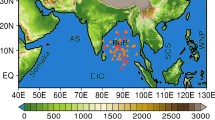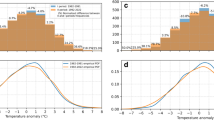Abstract
The presence of dry fluvial river channels and the intense cloud activity in the south pole of Titan over the past few years1,2,3 suggest the presence of methane rain. The nitrogen atmosphere of Titan therefore appears to support a methane meteorological cycle that sculptures the surface and controls its properties1,4. Titan and Earth are the only worlds in the Solar System where rain reaches the surface, although the atmospheric cycles of water and methane are expected to be very different5. Here we report three-dimensional dynamical calculations showing that severe methane convective storms accompanied by intense precipitation may occur in Titan under the right environmental conditions. The strongest storms grow when the methane relative humidity in the middle troposphere is above 80 per cent, producing updrafts with maximum velocities of 20 m s-1, able to reach altitudes of 30 km before dissipating in 5–8 h. Raindrops of 1–5 mm in radius produce precipitation rainfalls on the surface as high as 110 kg m-2 and are comparable to flash flood events on Earth6.


Similar content being viewed by others
References
Porco, C. et al. An overview of Titan from the Cassini spacecraft. Nature 434, 159–168 (2005)
Tomasko, M. G. et al. Rain, winds and haze during the Huygens probe's descent to Titan's surface. Nature 438, 765–778 (2005)
Roe, H. G., de Pater, I., Macintosh, B. A. & McKay, C. P. Titan's clouds from Gemini and Keck adaptive optics imaging. Astrophys. J. 581, 1399–1406 (2002)
Lebreton, J. P. et al. An overview of the descent and landing of the Huygens probe on Titan. Nature 438, 758–764 (2005)
Lorentz, R. D., McKay, C. P. & Lunine, J. I. Photochemically driven collapse of Titan's atmosphere. Science 275, 642–645 (1997)
Maddox, R. A. Mesoscale convective complexes. Bull. Am. Meteorol. Soc. 61, 1374–1387 (1980)
Grifftith, C. A., Owen, T., Miller, G. A. & Geballe, T. R. Transient clouds in Titan's lower atmosphere. Nature 359, 575–578 (1998)
Griffith, C. A., Hall, J. L. & Geballe, T. R. Detection of daily clouds on Titan. Science 290, 509–513 (2000)
Brown, M. E., Bouchez, A. H. & Griffith, C. A. Direct detection of variable tropospheric clouds near Titan's south pole. Nature 420, 795–797 (2002)
Roe, H. G., Brown, M. E., Schaller, E. L., Bouchez, A. H. & Chadwick, A. Geographic control of Titan's mid-latitude clouds. Science 310, 477–479 (2005)
Griffith, C. A. et al. The evolution of Titan's mid-latitude clouds. Science 310, 474–477 (2005)
Awal, M. & Lunine, J. I. Moist convective clouds in Titan's atmosphere. Geophys. Res. Lett. 21, 2491–2494 (1994)
Tokano, T. Meteorological assessment of the surface temperatures on Titan: constraints on the surface type. Icarus 173, 222–242 (2005)
Lorenz, R. D., Griffith, C. A., Lunine, J. I., McKay, C. P. & Rennò, N. O. Convective plumes and the scarcity of Titan's clouds. Geophys. Res. Lett. 32, L01201, doi:10.1029/2004GL021415 (2005)
Rannou, P., Montmessin, F., Hourdin, F. & Lebonnois, S. The latitudinal distribution of clouds on Titan. Science 311, 201–205 (2006)
Elachi, C. et al. Cassini radar views the surface of Titan. Science 308, 970–974 (2005)
Hueso, R. & Sánchez-Lavega, A. A three-dimensional model of moist convection for the giant planets: the Jupiter case. Icarus 151, 257–274 (2001)
Hueso, R. & Sánchez-Lavega, A. A three-dimensional model of moist convection for the giant planets II: Saturn's water and ammonia moist convective storms. Icarus 172, 255–271 (2004)
Lorenz, R. The life, death and afterlife of a raindrop on Titan. Planet. Space Sci. 41, 647–655 (1993)
Houze, R. Cloud Dynamics Ch. 3 (Academic Press, San Diego, 1994)
Thompson, W. R., Zollweg, J. A. & Gabis, D. H. Vapor-liquid equilibrium thermodynamics of N2 + CH4—Model and Titan applications. Icarus 97, 187–199 (1992)
Lellouch, E. Titan's atmosphere and hypothesized ocean: A reanalysis of the Voyager 1 radio-occultation and IRIS 7.7 µm data. Icarus 79, 328–349 (1989)
Niemann, H. B. et al. The abundances of constituents of Titan's atmosphere from the GCMS instrument on the Huygens probe. Nature 438, 779–784 (2005)
Samuelson, R. E., Nath, N. R. & Borysow, A. Gaseous abundances and methane supersaturation in Titan's troposphere. Planet. Space Sci. 45, 959–980 (1997)
Fulchignoni, M. et al. In situ measurements of the physical characteristics of Titan's environment. Nature 438, 785–791 (2005)
Tao, W. K. et al. Microphysics, radiation and surface processes in Goddard Cumulus Ensemble (GCE) model. Meteor. Atmos. Phys. 82, 97–137 (2003)
Schaller, E. L., Brown, M. E., Roe, H. G. & Bouchez, A. H. A large cloud outburst at Titan's south pole. Icarus 182, 224–229 (2006)
Press, W. H., Teukolsky, S. A., Vetterling, W. T. & Flannery, B. P. Numerical Recipes 829 (Cambridge Univ. Press, Cambridge, 1992)
Acknowledgements
This work was supported by the MCYT Plan Nacional de Astronomía y Astrofísica, Grupos UPV and Fondos FEDER. R.H. was supported by the “Ramón y Cajal” programme. The SGI/IZO-SGIker UPV/EHU is gratefully acknowledged for allocation of computational resources.
Author information
Authors and Affiliations
Corresponding authors
Ethics declarations
Competing interests
Reprints and permissions information is available at npg.nature.com/reprintsandpermissions. The authors declare no competing financial interests.
Supplementary information
Supplementary Notes
This file contains Supplementary Figures 1 and 2 and Supplementary Table 1. Supplementary Figure 1 details methane molar mixing and saturation ratio profiles used in the simulations. Supplementary Figure 2 details the merger of two nearby convective cells triggered simultaneously. Supplementary Table 1 shows Additional simulations and results of Titan’s convective clouds. (DOC 967 kb)
Rights and permissions
About this article
Cite this article
Hueso, R., Sánchez-Lavega, A. Methane storms on Saturn's moon Titan. Nature 442, 428–431 (2006). https://doi.org/10.1038/nature04933
Received:
Accepted:
Issue Date:
DOI: https://doi.org/10.1038/nature04933
- Springer Nature Limited
This article is cited by
-
Science goals and new mission concepts for future exploration of Titan’s atmosphere, geology and habitability: titan POlar scout/orbitEr and in situ lake lander and DrONe explorer (POSEIDON)
Experimental Astronomy (2022)
-
A post-Cassini view of Titan’s methane-based hydrologic cycle
Nature Geoscience (2018)
-
AVIATR—Aerial Vehicle for In-situ and Airborne Titan Reconnaissance
Experimental Astronomy (2012)
-
Organic chemistry on the surface of Titan
Rendiconti Lincei (2011)





